
In American golf there are more golf course rating debates than I care to consider. Shinnecock over National Golf Links? Cypress over Pebble? Century old shrines vs. Doak and Crenshaw masterpieces stuck in East Gooberville sand dunes ...
But in the UK and Ireland, while plenty discuss whether the R&A should drop some courses from the Open Championship rota or perhaps whether Donald Trump should be tried in The Hague for his Scottish plunder, no debate endures quite like Royal County Down vs. Royal Portrush. Few places in the world are as fortunate in golf terms and as cursed in political reality as Northern Ireland, home not only to three winners of recent majors but two consensus world top-ten courses little more than two hours apart.
The two royals are monuments to coherent design, relentless challenge and classic links beauty, and they've remained stunningly great for so long -- both were born in the late 1880's -- that grandfathers still proudly carry on the friendly feud as to which is best. We're not saying this should really matter at a time when the global economy teeters on the brink of becoming, well, Iceland, but we must occupy our time.
County Down Golf Club is located in Newcastle, a wee burg of some 8,000 roughly an hour south of Belfast, snugly beneath the purple and poetic Mourne Mountains and beside the Irish Sea. Newcastle, as many golfers throughout all of Ireland call the famous course, was laid out by Old Tom Morris in 1898, then tweaked by
Harry Vardon in 1908 and further furbished in 1926 by designer Harry Colt, who was tasked with reducing the number of blind drives, a mission that the course's few critics will say remains un-accomplished. I don't mind them that much, but they'll always trouble first-timers who aren't playing with members or caddies.
County Antrim's Royal Portrush -- and here we're always talking about its Dunluce course, though Norn Iron native David Feherty told me once that the sister Valley course may be "the most under-rated course in Ireland" -- is also located in a seaside resort of about the same size as Newcastle, just over an hour north of Belfast. No gorgeous mountain views here, but more fine beaches -- the West and East strands -- and unquestionably a livelier nightlife, with Northern Ireland's largest nightclub complex, at Kelly's. The course was opened in 1888 but it was not until 1933 that designer Harry Colt shaped what we see today, a canvass not unlike County Down, but with somewhat smaller dunes.
There are plenty of similarities between the courses. Both have their share of smallish greens and impenetrable thorny gorse (U. europaeus) that erupts in yellow, pea-size spring blossoms. But County Down, with its backdrop of mountains and the iconic Slieve Donard hotel, is so much more photogenic and popular in coffee table golf books one might think only its gorse actually bloomed. Both lean Protestant and British, of course, but are welcoming to all, with Portrush a bit more middle class than the banker-Brahmins in Newcastle. Portrush also claims one of the most competent and personable club managers in all of Irish golf, Wilma Erskine.

Portrush has a decent driving range -- most courses over here have none, including County Down -- fewer blind tee shots, yet more diabolically sloped greens, not unlike the steep upholstered edges of an old Ford Mustang. The effective landing area of a Portrush green is often reduced by 25 percent or more, I would guess, by the rounded drop-offs that send errant shots hurtling off to bunkers or calf-high grass. County Down gets the nod on gorgeous elevated tee box vistas, yet neither really feature the ocean as much as, say, Enniscrone, Sligo or Ballybunion. I've never heard anyone disagree that County Down is a few shots harder.
In 2009, Golf Digest ranked County Down as the No. 1 course in the world outside the United States, with Portrush at No. 4, ahead of cathedrals such as Turnberry, Dornoch, Ballybunion and seven British Open venues. A more diverse international ratings panel with "Top 100 Golf Courses of the World" places County Down at No. 4, behind Pine Valley, Cypress Point and Augusta (all U.S.), with Portrush No. 14. I wouldn’t argue strongly with any of this.
The trials of 6,845-yard Portrush start innocently enough -- if the wind isn't defoliating your face. At the first tee you meet a slightly downhill 392-yard par-four, with a tough uphill second shot onto a green 40 paces deep. No. 2 is an uphill but manageable 505-yard par-five, where you can begin looking for Darren Clarke's new home somewhere off in the woods. Perhaps you’ll start with two pars. Splendid day, isn't it? World top-ten my tiny arse, you're thinking. Slowly the noose tightens as you head off to the cold Atlantic.
The links stereotype is that you can always run your ball up the front of the green. We wish that were so. Sometimes the mounding funnels your well-intentioned shots into dark fertile gulleys where you might still find missionaries or a few of Portrush's sweet blackberries.
Off the tee, listen to your inner caddy -- absolutely nothing is more important than staying in the fairway, even if this means not hitting a logical club that you hit well back home. Repeat after me: Sometime today I will hit a low five-iron so that I can find it and at least sniff par, instead of hitting a hybrid into the Duke of Whimsy's adjoining castle.
Let's not say the words "signature hole," but as I walk to Portrush's glorious No. 5, I always inhale deeply and thank the authorities for another day. It's a 411-yard downhill four that doglegs right through a Himalayan range of gnarly dunes. Every fiber of your being says cut the corner, go for the glory, but if there's any wind ... take a Sherpa. It's hardly the course's toughest hole, but the view from the elevated green, perched some 50 feet above a wide, luscious beach and the churning dark Atlantic, stands tall in Irish golf. That's a Scottish archipelago barely 20 miles beyond the wet-suited surfers and bottlenose dolphins.

Buckle your swashes for Portrush's world-famous No. 14, Calamity, a maniacal 210-yard par-three that clings to a 100-foot precipice over a chasm of sea buckthorn and utter doom. Golfers far better than us have crashed here. By the 17th you'll need some comic relief, and off to the right, thar she blows -- Big Nellie, one of the largest and highest bunkers in all of golf, an amphitheater of sand some 50 feet high, 20 feet deep and 70 across that could hold the Mormon Tabernacle Choir. Aim left.
The familiar criticism of Portrush is that its two finishing holes are simply average. Not dumb, not contrived, just not spectacular. No oceans or grand vistas, just the clubhouse, the car park and a little street life. You might make par actually, but as you stagger off 18 like a Viking home from a seal hunt, remind yourself that a wee lad down the road named Rory McIlroy set the course record here at 61. He was 16 at the time.
I know. I know. Youth is wasted on the young.
A parting Portrush thought: "If you could put Portrush’s greens on County Down's site," says Golf Digest architecture editor Ron Whitten, "you'd have the greatest course in the world."
Royal County Down is so sure of its place in the golf firmament that 50 yards from its leafy front gates a first-time visitor might think he has taken a wrong turn into a nursing home. I'm quite fine with not having Magnolia Lane and all the country club pomp we’ve come to expect in America, but I'm still shocked and wondrously grateful that just about any hacker with a handicap card can walk into these world top-tens, plunk down your pounds and tee it up. Take heed, Pine Valley.
County Down probably has the best conditioning of any Irish course I've played, though you should never expect greens here to run much faster than 10 on the Stimp. A Portrush member and confidant once told me: "The main difference between Portrush and Newcastle is that RCD still thinks they're slightly above the lower classes who play at Portrush, whereas we think they have perhaps the better course but a worse attitude."
Chances are you'll be too awed to notice as you walk past the manicured garden hedges and undulating practice area, groomed like a Manhattan poodle's caboose. Welcome to one of the most photographed courses in the world. Those are your knees wobbling.
The inspiring No. 9 -- Dundrum Bay to the left, dense canyons of yellow gorse framing the fairways, misty 2,786-foot Slieve Donard peak (Northern Ireland's highest) looming over the eponymous redbrick Victorian hotel by the clubhouse -- is so enthralling I stealthily climbed a dune at 6 one morning to watch it change colors. Shafts of sunlight danced through a low leaden sky, making the Mourne mountains seem larger and alive -- a brooding purple one moment, a golden Julie Andrews backdrop the next.
"It is the single most beautiful sight in all of golf," says Feherty, whom I promise will not be quoted again. (This incomparable hole is also on the cover of a must pre-trip read for your Ireland golf trip, Links of Heaven, by Richard Phinney and Scott Whitley.)
Hole-by-hole tributes aren't necessary at County Down. It is the totality of this place, the unrelenting but fair challenge in every hole, the seamless routing, an absence of anything contrived, that spawns its near-universal acclaim.
The irony is that County Down, 7,181 yards from the tips and demonstrably superior to most British Open venues, has so many exceptional but TV-deprived holes that none has become a folk hero–cum–drama queen like, say, TPC Sawgrass’ Island Green or Carnoustie's 18th. For comparison's sake, County Down has far more bunkers than Portrush, and they're of the tufted, marram-fringed, Groucho eyebrows variety. The par fours are also longer, and you can often putt from 50 feet off the green. Fair warning to those who cannot countenance blind shots: County Down has several famous ones off the tee that even the official yardage guide terms “terrifying.” This is why you beg and scheme to play with a member.
So, given all this, what would qualify these two courses to be among the world's ten best?
A month after playing them for the first time, most alert golfers can describe in some detail at least six holes from each. The overwhelming sensation is that all 18 holes offer vexing new challenges without loss of continuity. There are repeated glimpses of quiet terror and exhilaration, even some Big Nellie eccentricity, but nothing seems thoughtlessly unfair. The course seems designed by one mind.
People are briskly walking, laughing, with grateful smiles on their faces. There's no valor in making a brutal bar-exam golf course, but par is still special here.
And, though design purists might argue the pertinence, each course is certainly wrapped in unforgettable natural beauty that reminds us of what came before golf.
** Former Sports Illustrated writer, Bruce Selcraig, lives in Austin and writes for The New York Times Magazine, The Atlantic and Mother Jones, among others. You can reach him at selcraig@swbell.net.














